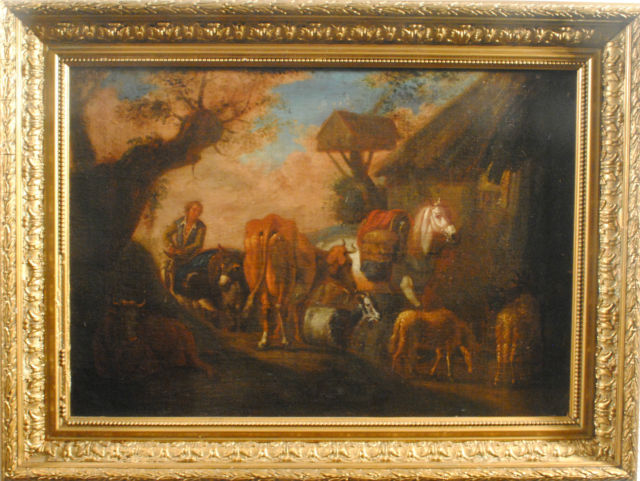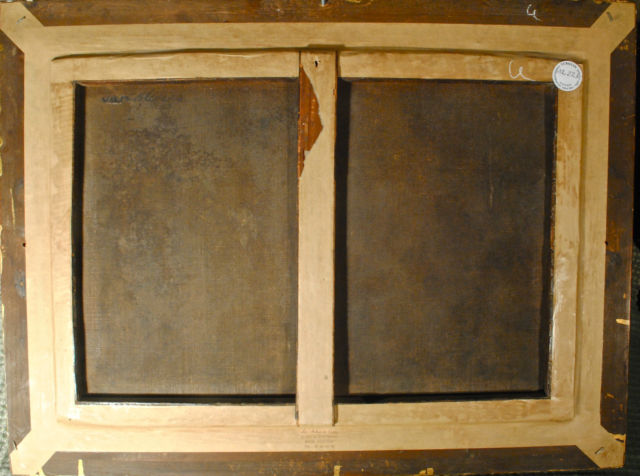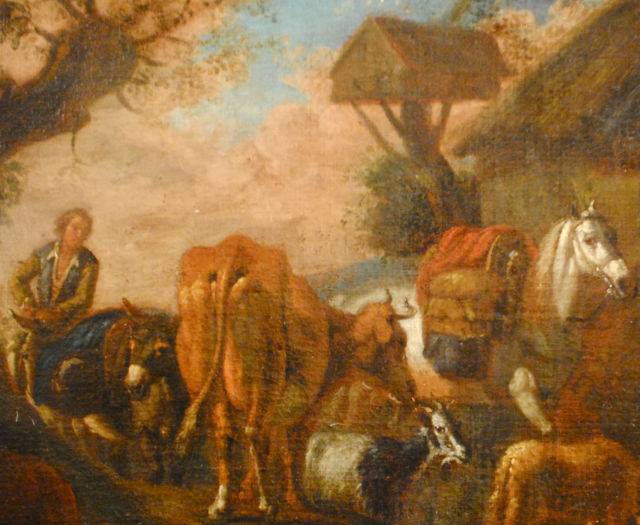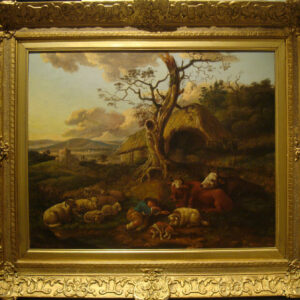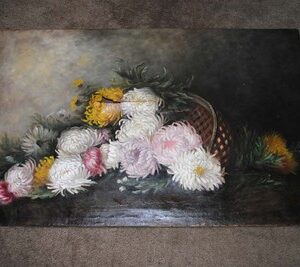Description
A Herdsman entering a Village with his Cattle, Flemish Old Master, Pieter Van Bloemen, c. 1690.
Pieter Van Bloemen (1657-1720)
Pieter Van Bloemen was born in Antwerp, the brother of Jan Frans and Norbert Van Bloemen. He began as a student of Simon Van Douw, and by 1673 he became a Master in the Guild of St. Luke. At that point, Van Bloemen moved to Rome, where he stayed for over 20 years, making his fame and fortune. Van Bloemen visited Lyon, France, where he painted with Adriaen van der Cabel and Gillis Weenix, two of his countrymen. In 1694, he returned to Antwerp, where he inaugurated a studio with eight students.
Pieter Van Bloemen, throughout his career focused in the main on his depiction of animals, but also on resting travelers, historical, military and genre scenes. He truly perfected the study of animals in their varied phases, and excelled in the mise-en-scène placement of animals in his paintings for maximum impact. The years he spent in Italy are well-reflected in Bloemen’s oils, in terms of warmth, coloring and drama. The Italian influence continued throughout his painterly career.
The depiction of the sky and the clouds is quintessentially that of Pieter Van Bloemen. This motif of sky viewed through the aperture of clouds was often seen in Van Bloemen’s oils, such as in Horsemen and Dogs hunting a Bull, Animals and Wagons crossing a Stream, Italian Landscape with Cattle, The Duke of Marlborough and the Earl of Cadogan at Blenheim, Soldiers resting in a Village, Riders in a Roman Landscape, and many others
Pieter Van Bloemen’s paintings are to be found in the world’s leading museums, including: The Louvre, The Hermitage, The Prado, The Metropolitan Museum, Musee des Beaux-Arts in Lille, Amsterdam’s Rijksmuseum, the Fitzwilliam Museum in Cambridge, the Städelsches Museum in Frankfurt-am-Main, the Berlin Museum, the Royal Museum of Fine Arts in Antwerp, Galleria Barberini in Rome, England’s National Trust, The Victoria and Albert Museum, The York Museum, and many others.
Van Bloeman’s mastery in the depiction of animals and genre scenes, always with an Italianate flair, is overwhelming.
A Herdsman entering a Village with his Cattle is offered in traditional auction fashion for a limited 10-day period.
The reserve is modest in the extreme for this antique Old Master painting. The composition is excellent, details are superb, and the colors are exceedingly well-balanced. As always, Pieter Van Bloemen pays close attention to excruciating detail.
A Herdsman entering a Village with his Cattle has recently been acquired in Paris, under the auspices of a long-established venue of impeccable standing.
A Herdsman entering a Village with his Cattle has been vetted by the renowned firm of Eric Turquin & Co. of Paris, the leading art authentication and appraisal company in France. The seal of Turquin & Co. has thus been affixed to the reverse of the painting, as shown.
The term “Old Master” is commonly accepted usage referring to a European painter or artist who worked before the year 1800. In other words, paintings of the 19th century would be considered “too recent” to be included in this category. Neither John Constable nor Eugène Delacroix would be classified as Old Masters. The list of recognized Old Masters is rather long, and includes such names as: Pieter Bruegel the Elder (Flemish 1525-1569); El Greco (Spanish 1541-1614); David Teniers the Younger (1610–1690); Meindert Hobbema (1638-1709); Caravaggio (Italian 1573-1610); Rembrandt van Rijn (Dutch, 1606–1669); Nicolas Poussin (French, 1594–1665); Johannes Vermeer (Dutch, 1632–1675); Joshua Reynolds (English, 1723–1792) and numerous others.
The works of the Old Masters are, of course, increasingly difficult to find and have enjoyed a correspondingly steady rise in prices. Nevertheless, they represent a much more sound investment than the fluctuations of today’s financial markets. One could sleep much more soundly with an Old Master painting on the wall than a rapidly-declining stock market portfolio.
The paintings of the Old Masters represent a much more secure investment, esthetically as well as financially, that the vagaries of today’s stock market.
Pieter Van Bloemen’s paintings have maintained increasingly higher prices at auction. A Cavalry Party halted before an Inn sold at Sotheby’s in 2009 for 12,500 British Pounds. Herdsmen with Horses and Sheep in the Foreground, a Battle beyond brought 14,900 British pounds.
Christie’s has frequently offered the works of Pieter Van Bloemen at it’s Old Master auctions. A Blacksmith’s Forge with a Blacksmith branding a Horse was sold for $38, 170. Travellers on horseback by a blacksmith with peasants and their cattle near the ruin of the Basilica of Constantine and the San Francesco Romana brought a strong $25, 327.
A peasant couple amongst their cattle and sheep, attributed to Van Bloemen, was sold for $5, 035.
In the January 31, 2013 Old Master sale, Christie’s will offer two oils by Pieter Van Bloemen: Cavaliers setting off on a Journey; and A Military Blacksmith shoeing Horses by a Ruin. The sales estimates are between $25,000 and $35,000.
Herdsman entering a Village with his Cattle measures 27 1/8 inches x 20 1/2 inches framed, and 22 inches x 15 1/4 inches unframed. Small ancient restorations, with some small in-painting in bottom left corner, below resting cow.
johnbluebottlefineart

